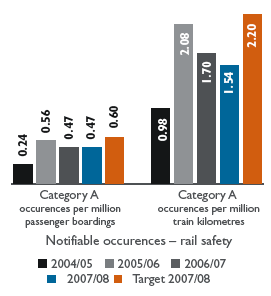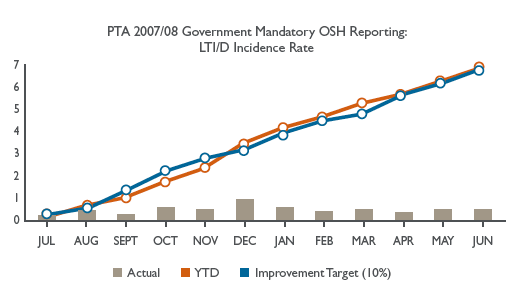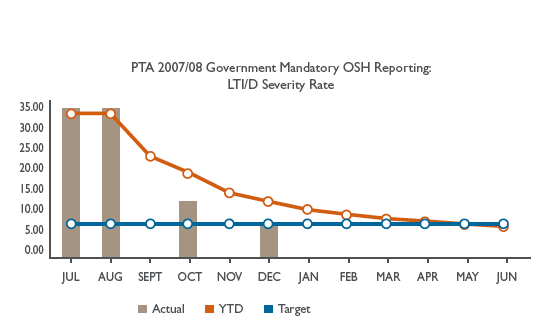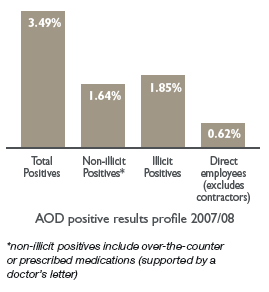Safety
The strong focus on safety as a core value of the organisation continued during the year. Representatives of the safety teams from across the PTA held a strategic safety planning day and identified seven key focus areas which formed the Health, Safety and Environment (HSE) Strategic Directions for the year. This document is updated annually and endorsed by the Executive HSE Management Committee to ensure a continued focus on strategic safety management.
Rail Safety
Accreditation
A major step was undertaken in overhauling the safety management system to meet the new requirements to AS 4292, and the anticipated national changes to rail safety requirements, including fatigue management, risk management and safety cultural programs.
Compliance inspections and reporting
The annual rail safety compliance audit was conducted by the Office of Rail Safety (ORS) in November 2007, and a report was issued on 4 January 2008. The rail safety audit did not identify any non-compliances, but found 12 observations, compared with three non-compliances and 27 observations the previous year. All observations were closed out by 28 March 2008.
Inquiries and inspections
The ORS did not request any Category A incidents be investigated under Section 39(3) of the Rail Safety Act (1998).
Notifiable occurrences
Railway safety incidents are recorded and notified to the ORS. These notifiable occurrences are defined in the Rail Safety Regulations 1999 as Category A (incidents causing serious injury, death, or significant damage) or Category B (incidents that may have the potential to cause a serious accident) and Australian Standard Railway Safety Management 4292 - 2006. Notifiable occurrence reporting is a legislated requirement under the Rail Safety Act 1998 for the accredited owner and operator of a rail system, and therefore part of the PTA’s safety management system. These arrangements do not cover bus operations.
The performance measurement for Category A and B occurrences is expressed as the number of occurrences per million passenger boardings and per million track kilometres. A low rate of incidents indicates that sound safety and risk management procedures/controls are operating effectively throughout the system. The benchmark values for Category A and B incidents are calculated on estimations of the number of future passenger boardings and train kilometres.
There were 20 Category A notifiable incidents in 2007/08, compared with 16 the previous year. Excluding incidents involving actions beyond the PTA’s control (i.e. suicides or attempted suicides), there were four Category As in 2007/08 and 10 in 2006/07.

Category A incidents per million passenger boardings and per million train kilometres were comparable to 2006/07.
There were 419 Category B notifiable incidents in 2007/08, compared with 627 the previous year. This is a significant reduction in notifiable occurrences before the increased passenger kilometres are taken into account.

Category Bs against passenger boardings and train kilometres were significantly lower than in 2006/07. The 2007/08 results for both categories were encouragingly lower than the respective benchmarks. The reduction in incidents reflects the PTA’s risk management initiatives and controls.
The PTA’s overall normalised figures for 2007/08 reduced considerably. This can be attributed to an improvement in safety performance and the increase in patronage and kilometres travelled as a result of the Mandurah Line – on which level crossings were designed out of the system to reduce risk – coming on stream.
Occupational safety and health
Several safety and health programs launched in 2006/07 continued throughout the year, including the Safety Topic of the Month campaign and the Safety STAR (Stop Think Assess Respond) marketing and hazard management program. These initiatives complement and promote the organisation’s long-term safety cultural change program. There were also several health initiatives including free annual influenza inoculations and mole check clinics conducted.
Training
Training in safety and health continued to be a priority, with many managers and supervisors completing a two-day training course on their occupational safety and health responsibilities. A contingent of PTA safety and health representatives, as well as several supervisors, managers and safety coordinators, attended the 2007 WorkSafe Forum where they heard from and questioned a panel of safety experts and presenters on various topics.
In-house training programs continue to be run regularly, including half and full-day corporate HSE inductions for, respectively, administrative and operational staff, and a full-day, interactive training course in conducting HSE investigations. Training in the management of violence, aggression and bullying was launched in 2007 and continues to be rolled out across the organisation. Fatigue management training for supervisors started in June 2008 and will be followed by training for employees in the coming year. Training in specific hazards, such as confined spaces, was also provided to targeted workers.
The PTA also coordinated a workshop on corporate governance and management responsibilities presented by leading British barrister Gerard Forlin. The workshops included attendees from PTA as well as representatives from key contractors, service providers and other stakeholders, including the ORS.
OSH reporting system
The PTA’s OSH reporting system, launched on 1 July 2004, enables the organisation to capture reported hazards, near-misses and incidents, and facilitates interrogation of data to analyse trends. Hazard reporting reached an all-time high this financial year, enabling the organisation to manage hazards proactively, before an incident occurs. The system is due to be upgraded in the next financial year.
OSH and injury management performance
Injury prevention and injury management continues to be a focus for the PTA. Previously-implemented changes to the PTA’s injury management procedures, including more transparent systems of work, proved to be helpful when managing long-term claims and reducing conflict during the day-today administration of the process. To support the continued development of injury management, a review of all procedures was conducted to ensure they were current and met statutory requirements of regulation and codes of practice.
| 2007/08 Target | 2007/08 Actual | % Difference from 2006/07 | |
|---|---|---|---|
|
Number of (employee) fatalities |
0 |
0 |
0 |
|
Lost time injury incidence rate |
6.08* |
6.12 |
-9.5% |
|
Lost time injury severity rate |
6.59* |
6.17 |
-15.67% |
* target = 10% reduction from 2006/07


The PTA again did not record a fatal incident to a worker on the system. Though the 10 per cent improvement target was not met, the 2007/08 lost time injury (LTI) incidence rate decreased by 9.5 per cent from the previous year. The 10 per cent improvement target for severe injuries was exceeded, reducing by 15.67 per cent from the previous year.
Slightly more than a third of the LTIs recorded during the year were due to pyschological trauma as a result of attempted or suspected suicides on the rail system. When these injuries are isolated, the incidence rate for all other injuries is 4.16, a 32.69 per cent reduction on the equivalent 2006/07 figure. This indicates that injuries within the direct control of the PTA to prevent, are decreasing at a faster rate than the total figure would suggest. The PTA will be working with mental health experts in the coming year to study the increasing impact of suspected or attempted suicides on our employees with a view to implementing further psychological resilience and recovery mechanisms.
Health assessment standards
On July 1 2004, the National Transport Commission introduced the National Standard for Health Assessment of Rail Safety Workers. The national standard applies to all rail safety workers as defined in the Rail Safety Act (1998). It relates to health assessments and procedures for monitoring the health and fitness of workers who perform rail safety duties. Regular updates continued to be provided across the organisation this year, to ensure the currency of safety critical health assessments was maintained. A post-implementation review of the introduction of the national standard was conducted, resulting in Executive approval of several actions to ensure the continuous improvement and efficiency of the PTA’s health management program.
Testing for alcohol and other drugs
Random and for-cause testing of employees and contractors for alcohol and other drugs continued throughout the year as part of the PTA’s alcohol and other drugs management program. Of the 431 random tests conducted, nine positive results due to illicit substances were recorded. Three of the illicit positive results were for direct PTA employees; six were for contractors. No illicit positive results were recorded following for-cause (post-incident) tests (n = 56).
Occupations of workers who tested positive for illicit substances included: track maintenance workers, transit officers and station staff. Illicit substance results included: alcohol; cannabinoids; sympathomimetic amines (amphetamine class); and cocaine. The PTA continues to monitor trends in alcohol and other drug use to ensure that its awareness sessions reflect these trends, thus maintaining relevance and maximising their impact.

Corruption prevention
The PTA has a comprehensive risk management strategy to prevent corruption. A Code of Conduct and a suite of policies and procedures exist and have been communicated to employees to guide them in their professional and personal conduct.
Audit and review practices are regularly undertaken across the PTA to ensure the applicability and take up of the Code and prevent misconduct and corruption.
Complaint and comment handling
The PTA welcomes feedback, including complaints, from its passengers. It treats all comments and complaints with a high priority and has in place information systems to log and track complaints. It provides responses to customers whenever requested, and has an auditable trail of actions where improvements are identified as necessary.
Although complaints and comments come from a variety of sources including commercial firms and other Government departments, which may not relate directly to passengers’ experiences, the greatest number come directly from customers.
The primary means of passengers registering comments or complaints is through the PTA CommentLine (13 16 08). This well-advertised telephone number takes comments on any aspect of PTA business, registers it on the CommentLine system, and forwards the comments/complaints to the appropriate division for action. The other key method for registering complaints is through the Transperth website. Additionally passengers occasionally submit comments, commendations or complaints in writing. Generally, complaints received via the PTA CommentLine telephone number and the website are responded to within seven days. In 2007/08, the PTA CommentLine dealt with 13,319 comments, of which 11,651 were complaints.
An extensive audit of the PTA's complaint management process in 2007 led to further improvements in procedures and systems, which were implemented in 2007/08. The improvements ensure that any written correspondence to the PTA is carefully scrutinised to determine whether it constitutes a complaint, and any relevant areas of complaint are recorded and managed in the complaints management system; by doing this the PTA has ensured that any emerging trends are captured, such as particular bus or train trips or services which are cause for complaint. Resources can then be focussed on non-performing services which are generating the complaints and remedial action to rectify the issue can be implemented.
Substantive equality
All Transperth operational staff, including passenger ticketing assistants, transit officers and bus drivers, receive comprehensive customer service training, with periodic refresher training. This training includes disability awareness, awareness of anti-discrimination requirements and, most importantly, PTA values.
Operational staff understand that all customers are valued and must be treated with courtesy and respect. Customers are afforded the opportunity to provide feedback on the level of service offered by our staff through the PTA CommentLine (13 16 08), and PTA management and supervisors use this feedback to constructively counsel staff and train them if their customer service performance is inadequate.
To further promote respect and positive customer interaction, the PTA recognises outstanding individual or team performance via monthly and annual customer service awards. View image Nominations for these monthly and annual awards are actively sought across the organisation with any member able to nominate a fellow worker's outstanding performance; the high visibility and profile of the awards in itself promotes a consciousness of the need for customer service. Standards of customer service are also independently assessed across the PTA's Transperth and Transwa systems via the annual PSM, the most extensive public transport survey of passenger satisfaction undertaken in Australia. Results of what our customers think about customer service are actively used to guide staff behaviour, improve training and refine the allocation of customer service resources.
Sustainability
The PTA Sustainability Action Plan 2005-2007 outlined a number of priority areas to maximise sustainability during the planning, development and operations of its integrated public transport system. The plan also encouraged PTA staff to actively participate in activities that make a contribution towards a better future. These activities included energy conservation, recycling and use of public transport.
In 2007/08, the PTA continued to work with relevant external parties to identify opportunities to maximise sustainability during the development and planning of transport services. This included:
- Transit Oriented Development (TOD) planning.
- Integration of infrastructure for pedestrians and cyclists.
- Protection and restoration of local air, water, soils, flora and fauna.
- Services to assist people with disabilities.
Highlights of the implementation of the PTA’s Sustainability Action Plan for 2007/08 include:
- Annual report submitted to the Western Australia Greenhouse Gas Inventory.
- Participation in workshops held to increase sustainability across the Planning and Infrastructure portfolio.
- Employee participation in the Business Clean-up Australia Day.
- Implementation of an environmental induction program.
- Continued implementation of the recommendations of the energy audit completed in 2006, including the use of energy-smart posters within offices.
- Continued implementation of the recommendations of a water audit (worked with the Water Corporation to identify improvement strategies including a trial of waterless urinals).
Many objectives and priorities of the Sustainability Action Plan are integrated into other PTA initiatives, for example:
- Extending the metropolitan rail system with the establishment of the Mandurah Line.
- Accessibility for people with disabilities.
- SmartRider ticketing system.
- Bus priority improvements to reduce transit times and improve OTR.
- Disability Access and Inclusion Plan.
Greenhouse gas emission initiatives
During 2007/08, the PTA:
- Continued implementation of its Sustainability Action Plan.
- Trialled the use of waterless urinals in the Public Transport Centre.
- Registered for energy efficiency opportunities with the Department of Resources, Energy and Technology.
- Conducted water efficiency assessments of two PTA sites to determine water-saving opportunities.
- Developed an online Greenhouse Gas Savings calculator which uses travel information (including the car size and distance travelled) to calculate a passenger’s greenhouse gas savings. This calculator is available on the Transperth website.
Disability access and inclusion plan (DAIP)
In 2007/08, the PTA continued to improve access to public transport for people with disabilities. The DAIP for 2007-2012 was released in July 2007, and highlights for 2007/08 included:
- Continued implementation of the Get on Board programs to encourage participation by the disabled community.
- Development and publication of pamphlet on Using Mobility Aids on Transperth’s Public Transport System.
- Launch of the RCCTS View image to provide an accessible shuttle service between Rockingham’s new train station, the CBD and the foreshore.
- Continued implementation of a 12-year program to progressively replace the existing fleet with new accessible buses. View image
- Continued administration of the Bus Shelters Grant Scheme, which provides dollar-for-dollar funding to local councils for the construction of accessible shelters at selected bus stops.
- Upgraded or replaced four train stations, including those at Victoria Park View image and Kelmscott View image (work on which is scheduled for completion in 2008/09).
- Commissioned the last of the 31 state-of-the-art, three-car trains, View image which are fully accessible.
- Officially opened two new regional train stations in Meckering View image and Doodlakine, stopping points for Transwa’s Prospector service, to provide an accessible entry point from the platform to the railcar for passengers with mobility issues.
- Continued recognition of Companion Cards to allow a companion to travel with a person with a permanent disability at no additional cost.
Recordkeeping
The PTA has continued the program of improvement for recordkeeping which commenced in 2007 after the approval of its Recordkeeping Plan by the State Records Commission. The PTA has demonstrated its commitment to meeting the State Records Commission’s minimum compliance requirements through the achievements as detailed below.
A recordkeeping effectiveness framework was implemented in 2007/08, which will be reported on annually. In addition, the PTA’s recordkeeping processes were tested under internal audit in 2007/08 and produced favourable outcomes (Compliance Requirement 1). The PTA has purchased an electronic document record management system, which will be implemented in 2009. During the detailed design phase of the system, the PTA has taken the opportunity to review the efficiency and effectiveness of its recordkeeping processes, including meeting the compliance requirements.
An online records training and awareness package for clerical, administrative and business staff was progressively implemented during 2007/08, with the majority of this group of staff having completed the training. Training packages for regional-based staff will be implemented in 2008/09. Training content is reviewed periodically to ensure it reflects current operational and administrative practices and processes. The online training program is regularly monitored and feedback will be sought from staff via survey. The PTA also continues to keep all staff informed on recordkeeping matters through regular intranet bulletins and informal training sessions (Compliance Requirement 2 and 3).
The PTA’s induction manual lists the employee’s recordkeeping roles and responsibilities and is communicated to all new staff at the induction training. In addition, PTA has made the online records training and awareness package mandatory for all new clerical, administrative and business staff since 2008 (Compliance Requirement 4).
Pricing policy
Government continued to maintain public transport fares at an affordable level by restricting fare increases to the change in CPI. In accordance with government policy student fares were held at 50 cents.
Transwa fares are established by the State Government to ensure affordability for regional Western Australians. For the 2007/08 financial year, Transwa had an average fare increase of seven per cent subject to a biennial review of the fares from 2009/10.
Transperth fare information is provided at www.transperth.wa.gov.au.
Transwa fare information is provided at www.transwa.wa.gov.au.
